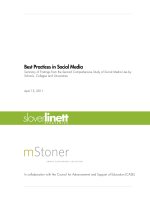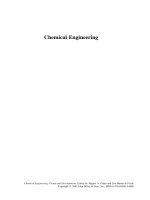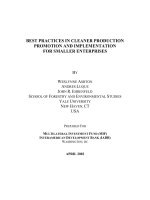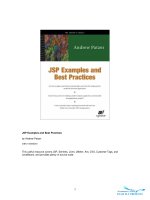Chemistry education best practices, opportunities and trends by javier garcía martínez, elena serrano torregrosa
Bạn đang xem bản rút gọn của tài liệu. Xem và tải ngay bản đầy đủ của tài liệu tại đây (8.67 MB, 795 trang )
Edited by
Javier Garc´ıa-Mart´ınez and
Elena Serrano-Torregrosa
Chemistry Education
Related Titles
Garc´ıa-Mart´ınez, J., Li, K. (eds.)
Armaroli, N., Balzani, V., Serpone, N.
Mesoporous Zeolites
Powering Planet Earth
Preparation, Characterization and
Applications
Energy Solutions for the Future
2013
2015
ISBN: 978-3-527-33409-4
ISBN: 978-3-527-33574-9
Quadbeck-Seeger, H.-J.
Garc´ıa-Mart´ınez, J. (ed.)
Nanotechnology for the
Energy Challenge
2nd Edition
World of the Elements
Elements of the World
2007
ISBN: 978-3-527-32065-3
2013
ISBN: 978-3-527-33380-6
Garc´ıa-Mart´ınez, J., Serrano-Torregrosa, E.
(eds.)
The Chemical Element
Chemistry’s Contribution to Our Global
Future
Ebel, H.F., Bliefert, C., Russey, W.E.
The Art of Scientific Writing
From Student Reports to Professional
Publications in Chemistry and Related
Fields
2nd Edition
2004
2011
ISBN: 978-3-527-32880-2
ISBN: 978-3-527-29829-7
Edited by Javier Garc´ıa-Mart´ınez and
Elena Serrano-Torregrosa
Chemistry Education
Best Practices, Opportunities and Trends
With a Foreword by Peter Atkins
The Editors
University of Alicante
Department of Inorganic Chemistry
Campus de San Vicente del Raspeig
03690 San Vincente del Raspeig
Alicante
Spain
All books published by Wiley-VCH are
carefully produced. Nevertheless, authors,
editors, and publisher do not warrant the
information contained in these books,
including this book, to be free of errors.
Readers are advised to keep in mind that
statements, data, illustrations, procedural
details or other items may inadvertently
be inaccurate.
Dr. Elena Serrano-Torregrosa
Library of Congress Card No.: applied for
Prof. Dr. Javier Garc´ıa-Mart´ınez
University of Alicante
Department of Inorganic Chemistry
Campus de San Vicente del Raspeig
03690 San Vincente del Raspeig
Alicante
Spain
British Library Cataloguing-in-Publication
Data
A catalogue record for this book is
available from the British Library.
Bibliographic information published by the
Deutsche Nationalbibliothek
Cover: (c) fotolia
The Deutsche Nationalbibliothek
lists this publication in the Deutsche
Nationalbibliografie; detailed
bibliographic data are available on the
Internet at <>.
© 2015 Wiley-VCH Verlag GmbH & Co.
KGaA, Boschstr. 12, 69469 Weinheim,
Germany
All rights reserved (including those of
translation into other languages). No part
of this book may be reproduced in any
form – by photoprinting, microfilm,
or any other means – nor transmitted
or translated into a machine language
without written permission from the
publishers. Registered names, trademarks,
etc. used in this book, even when not
specifically marked as such, are not to be
considered unprotected by law.
Print ISBN: 978-3-527-33605-0
ePDF ISBN: 978-3-527-67933-1
ePub ISBN: 978-3-527-67932-4
Mobi ISBN: 978-3-527-67931-7
oBook ISBN: 978-3-527-67930-0
Cover Design Grafik-Design Schulz
Typesetting Laserwords Private Limited,
Chennai, India
Printing and Binding Markono Print
Media Pte Ltd, Singapore
Printed on acid-free paper
V
Contents
Foreword XXI
Preface XXV
List of Contributors XXXIII
Part I: Chemistry Education: A Global Endeavour 1
3
1
Chemistry Education and Human Activity
Peter Mahaffy
1.1
1.2
1.3
1.4
1.4.1
1.4.1.1
1.4.1.2
Overview 3
Chemistry Education and Human Activity 3
A Visual Metaphor: Tetrahedral Chemistry Education 4
Three Emphases on Human Activity in Chemistry Education 5
The Human Activity of Learning and Teaching Chemistry 6
Atoms or Learners First? 6
Identifying Learners and Designing Curriculum to Meet Their
Needs 7
Effective Practices in the Human Activity of Learning and Teaching
Chemistry 8
Identifying and Eliminating Worst Practices as a Strategy? 8
Exemplar: Emphasizing the Human Activity of Learning and
Teaching Chemistry 9
The Human Activity of Carrying Out Chemistry 10
Explicit and Implicit Messages about the Nature of Chemistry 10
Breathing the Life of Imagination into Chemistry’s Facts 11
Exemplars: Emphasizing the Human Activity of Carrying Out
Chemistry 13
Chemistry Education in the Anthropocene Epoch 14
Planetary Boundaries: A Chemistry Course Outline? 15
Steps toward Anthropocene-Aware Chemistry Education 16
Exemplars: Anthropocene-Aware Chemistry Education 17
Teaching and Learning from Rich Contexts 18
Diving into an Ocean of Concepts Related to Acid–Base
Chemistry 18
1.4.1.3
1.4.1.4
1.4.1.5
1.4.2
1.4.2.1
1.4.2.2
1.4.2.3
1.4.3
1.4.3.1
1.4.3.2
1.4.3.3
1.5
1.5.1
VI
Contents
1.5.2
1.5.3
1.5.4
What Is Teaching and Learning from Rich Contexts? 20
Teaching and Learning from Rich Contexts – Evidence for
Effectiveness 21
From “Chemical” to “Chemistry” Education – Barriers to
Change 22
Acknowledgments 23
References 24
2
Chemistry Education That Makes Connections:
Our Responsibilities 27
Cathy Middlecamp
2.1
2.2
2.3
2.4
What This Chapter Is About 27
Story #1: Does This Plane Have Wings? 28
Story #2: Coaching Students to “See” the Invisible 30
Story #3: Designing Super-Learning Environments for Our
Students 34
Story #4: Connections to Public Health (Matthew Fisher) 37
Story #5: Green Chemistry Connections (Richard Sheardy) 39
Story #6: Connections to Cardboard (Garon Smith) 41
Story #7: Wisdom from the Bike Trail 44
Conclusion: The Responsibility to “Connect the Dots” 46
References 48
2.5
2.6
2.7
2.8
2.9
3
The Connection between the Local Chemistry Curriculum and
Chemistry Terms in the Global News: The Glocalization
Perspective 51
Mei-Hung Chiu and Chin-Cheng Chou
3.1
3.2
3.3
Introduction 51
Understanding Scientific Literacy 52
Introduction of Teaching Keywords-Based Recommendation
System 55
Method 56
Results 57
Example 1: Global Warming 57
Example 2: Sustainability 57
Example 3: Energy 58
Example 4: Acid 59
Example 5: Atomic Structure 60
Example 6: Chemical Equilibrium 61
Example 7: Ethylene 62
Example 8: Melamine 63
Example 9: Nano 64
Concluding Remarks and Discussion 65
Implications for Chemistry Education 68
Acknowledgment 70
References 70
3.4
3.5
3.5.1
3.5.2
3.5.3
3.5.4
3.5.5
3.5.6
3.5.7
3.5.8
3.5.9
3.6
3.7
Contents
4
Changing Perspectives on the Undergraduate Chemistry
Curriculum 73
Martin J. Goedhart
4.1
4.2
4.2.1
4.2.2
4.2.3
4.2.4
4.3
4.3.1
4.3.2
4.3.3
4.3.4
4.4
4.4.1
4.4.2
4.4.3
4.4.4
4.4.5
4.5
The Traditional Undergraduate Curriculum 73
A Call for Innovation 74
Constructivism and Research on Student Learning 74
New Technologies 76
The Evolving Nature of Chemistry 77
Developments in Society and Universities 77
Implementation of New Teaching Methods 78
The Interactive Lecture 79
Problem- and Inquiry-Based Teaching 80
Research-Based Teaching 80
Competency-Based Teaching 81
A Competency-Based Undergraduate Curriculum 83
The Structure of the Curriculum 84
Competency Area of Analysis 86
Competency Area of Synthesis 88
Competency Area of Modeling 89
The Road to a Competency-Based Curriculum 90
Conclusions and Outlook 92
References 93
5
Empowering Chemistry Teachers’ Learning: Practices and New
Challenges 99
Jan H. van Driel and Onno de Jong
5.1
5.2
5.2.1
5.2.2
5.2.3
5.3
5.3.1
5.3.2
Introduction 99
Chemistry Teachers’ Professional Knowledge Base 102
The Knowledge Base for Teaching 102
Chemistry Teachers’ Professional Knowledge 103
Development of Chemistry Teachers’ Professional Knowledge 105
Empowering Chemistry Teachers to Teach Challenging Issues 107
Empowering Chemistry Teachers for Context-Based Teaching 107
Empowering Chemistry Teachers to Teach about Models and
Modeling 109
Empowering Chemistry Teachers to Use Computer-Based
Technologies for Teaching 111
New Challenges and Opportunities to Empower Chemistry Teachers’
Learning 113
Becoming a Lifelong Research-Oriented Chemistry Teacher 113
Learning Communities as a Tool to Empower Chemistry Teachers’
Learning 114
Final Conclusions and Future Trends 116
References 118
5.3.3
5.4
5.4.1
5.4.2
5.5
VII
VIII
Contents
6
Lifelong Learning: Approaches to Increasing the Understanding of
Chemistry by Everybody 123
John K. Gilbert and Ana Sofia Afonso
6.1
6.2
The Permanent Significance of Chemistry 123
Providing Opportunities for the Lifelong Learning of
Chemistry 123
Improving School-Level Formal Chemistry Education 123
Formal Lifelong Chemical Education 125
Informal Chemical Education 126
Emphases in the Provision of Lifelong Chemical Education 127
The Content and Presentation of Ideas for Lifelong Chemical
Education 129
The Content of Lifelong Chemical Education 129
The Presentation of Chemistry to Diverse Populations 130
Pedagogy to Support Lifelong Learning 131
Criteria for the Selection of Media for Lifelong Chemical
Education 133
Science Museums and Science Centers 133
Museums 133
Science Centers 134
Print Media: Newspapers and Magazines 134
Print Media: Popular Books 135
Printed Media: Cartoons, Comics, and Graphic Novels 136
Three Allied Genre 136
The Graphic Novel 137
The Educational Use of Graphic Novels in Science Education 138
Case Study: A Graphic Novel Concerned with Cancer
Chemotherapy 140
Radio and Television 140
Digital Environments 141
Citizen Science 143
An Overview: Bringing About Better Opportunities for Lifelong
Chemical Education 144
References 146
6.2.1
6.2.2
6.2.3
6.2.4
6.3
6.3.1
6.3.2
6.4
6.5
6.6
6.6.1
6.6.2
6.7
6.8
6.9
6.9.1
6.9.2
6.9.3
6.9.4
6.10
6.11
6.12
6.13
Part II: Best Practices and Innovative Strategies
149
7
Using Chemistry Education Research to Inform Teaching Strategies
and Design of Instructional Materials 151
Renée Cole
7.1
7.2
7.3
7.3.1
7.3.2
Introduction 151
Research into Student Learning 153
Connecting Research to Practice 154
Misconceptions 154
Student Response Systems 157
Contents
7.3.3
7.3.4
7.3.5
7.3.6
7.3.7
7.4
7.4.1
7.4.2
7.4.3
7.5
7.6
Concept Inventories 158
Student Discourse and Argumentation 159
Problem Solving 161
Representations 161
Instruments 163
Research-Based Teaching Practice 165
Interactive Lecture Demonstrations 166
ANAPOGIL: Process-Oriented Guided Inquiry Learning in
Analytical Chemistry 167
CLUE: Chemistry, Life, the Universe, and Everything 169
Implementation 171
Continuing the Cycle 172
References 174
8
Research on Problem Solving in Chemistry 181
George M. Bodner
8.1
8.2
Why Do Research on Problem Solving? 181
Results of Early Research on Problem Solving in General
Chemistry 184
What About Organic Chemistry 186
The “Problem-Solving Mindset” 192
An Anarchistic Model of Problem Solving 193
Conclusion 199
References 200
8.3
8.4
8.5
8.6
9
Do Real Work, Not Homework 203
Brian P Coppola
9.1
9.1.1
9.1.2
9.2
9.2.1
9.2.1.1
9.2.1.2
9.2.1.3
9.2.1.4
9.2.1.5
9.2.2
9.2.2.1
9.2.2.2
9.2.2.3
9.2.3
9.2.3.1
9.2.3.2
9.2.3.3
Thinking About Real Work 203
Defining Real Work: Authentic Learning Experiences 203
Doing Real Work: Situated Learning 206
Attributes of Real Work 209
Balance Convergent and Divergent Tasks 209
Convergent Assignments 212
Divergent Assignments 213
Balancing Convergent and Divergent Assignments 214
Convergent Assignments in Team Learning 215
Divergent Assignments in Team Learning 216
Peer Presentations, Review, and Critique 218
Calibrated Peer Review 221
Guided Peer Review and Revision 221
Argumentation and Evidence 222
Balance Teamwork and Individual Work 222
Team-Based Learning: Face-to-Face Teams 222
Team-Based Learning: Virtual Teams 223
Team-Based Learning: Laboratory Projects 223
IX
X
Contents
9.2.3.4
9.2.3.5
9.2.4
9.2.4.1
9.2.4.2
9.2.4.3
9.2.4.4
9.2.4.5
9.2.4.6
9.2.4.7
9.2.4.8
9.2.5
9.2.5.1
9.2.5.2
9.2.5.3
9.2.5.4
9.2.5.5
9.2.5.6
9.2.6
9.2.6.1
9.2.6.2
9.2.6.3
9.2.6.4
9.2.6.5
9.2.6.6
9.2.6.7
9.3
9.3.1
9.3.2
9.3.3
9.3.4
9.3.5
9.3.6
9.4
Team-Based Learning: Collaborative Identification 223
Team-Based Learning: Experimental Optimization 224
Students Use the Instructional Technologies 224
Learning by Design 224
Electronic Homework System: In the Classroom 225
Student-Generated Videos 225
Student-Generated Animations 225
Student-Generated Video Blogs 226
Wikipedia Editing 227
Wiki Environment 227
Student-Generated Metaphors 227
Use Authentic Texts and Evidence 228
Literature Summaries 228
Literature Seminars 229
Public Science Sources 230
Generating Questions 230
Course-Based Undergraduate Research Experiences
(CURE) 230
Interdisciplinary Research-Based Projects 231
As Important to the Class as the Teacher’s
Work 232
Student-Generated Instructional Materials 232
Wiki Textbooks 232
Print and Web-Based Textbooks 233
Electronic Homework Systems 235
Podcasts 236
Classroom: Active-Learning Assignments 238
Laboratory: Safety Teams 239
Learning from Real Work 239
Evidence of Creativity through the Production of Divergent
Explanations 240
Peer Review and Critique Reveal Conceptual
Weaknesses 240
Team Learning Produces Consistent Gains in Student
Achievement 241
Students Use Instructional Technologies 242
Using Authentic Materials Result in Disciplinary Identification and
Socialization 243
Student-Generated Instructional Materials Promotes Metacognition
and Self-Regulation 244
Conclusions 245
Acknowledgments 247
References 247
Contents
10
Context-Based Teaching and Learning on School and University
Level 259
Ilka Parchmann, Karolina Broman, Maike Busker, and Julian Rudnik
10.1
10.2
Introduction 259
Theoretical and Empirical Background for Context-Based
Learning 260
Context-Based Learning in School: A Long Tradition with Still Long
Ways to Go 261
Further Insights Needed: An On-Going Empirical Study on the
Design and Effects of Learning from Context-Based Tasks 263
Strategies to Approach Context-Based Tasks 265
Application of Chemical Knowledge 267
Outlook on the Design of Tasks and Research Studies 269
Context-Based Learning on University Level: Goals and
Approaches 269
Design of Differentiated CBL-Tasks 271
Example 1 Physical and Chemical Equilibria of Carbon
Dioxide – Important in Many Different Contexts 272
Example 2 Chemical Switches – Understanding Properties like Color
and Magnetism 273
Feedback and Implications 275
Conclusions and Outlook 275
References 276
10.3
10.4
10.4.1
10.4.2
10.4.3
10.5
10.5.1
10.5.2
10.5.3
10.5.4
10.6
11
Active Learning Pedagogies for the Future of Global Chemistry
Education 279
Judith C. Poë
11.1
11.1.1
11.1.2
11.1.3
11.1.4
11.1.4.1
11.1.4.2
Problem-Based Learning 280
History 281
The Process 281
Virtual Problem-Based Learning 283
The Problems 285
Selected Problems for Introductory Chemistry at the UTM 285
Project for a UTM Upper Level Bioinorganic Chemistry
Course 288
PBL – Must Content Be Sacrificed? 289
Service-Learning 290
The Projects 291
Selected Analytical/Environmental Chemistry Projects 291
Selected Projects in Chemistry Education 292
Project for an Upper Level Bioinorganic Chemistry Course at
UTM 293
Benefits of Service-Learning 294
11.1.5
11.2
11.2.1
11.2.1.1
11.2.1.2
11.2.1.3
11.2.2
XI
XII
Contents
11.3
11.4
Active Learning Pedagogies 296
Conclusions and Outlook 297
References 297
12
Inquiry-Based Student-Centered Instruction 301
Ram S. Lamba
12.1
12.2
12.3
Introduction 301
Inquiry-Based Instruction 303
The Learning Cycle and the Inquiry-Based Model for Teaching and
Learning 304
Information Processing Model 308
Possible Solution 308
Guided Inquiry Experiments for General Chemistry: Practical
Problems and Applications Manual 310
Assessment of the Guided-Inquiry-Based Laboratories 314
Conclusions 316
References 317
12.4
12.5
12.6
12.7
12.8
319
13
Flipping the Chemistry Classroom with Peer Instruction
Julie Schell and Eric Mazur
13.1
13.2
13.2.1
13.2.2
13.2.3
13.2.4
13.2.5
13.3
13.3.1
13.3.1.1
13.3.1.2
13.3.1.3
13.3.1.4
Introduction 319
What Is the Flipped Classroom? 320
Three Big Ideas about Flipped Classrooms 321
Blended Learning and Flipped Classrooms 322
A Brief History of the Flipped Classroom 323
Traditional versus a Flipped Chemistry Classroom 323
Flipped Classrooms and Dependency on Technology 324
How to Flip the Chemistry Classroom 325
Common Myths about Flipped Classrooms 326
Myth 1: Flipped Classrooms are Just Video Lectures 326
Myth 2: Flipped Classrooms Have No Lectures 326
Myth 3: Students Won’t Be Prepared for Class 327
Myth 4: Flipping Your Classroom Means Changing Everything
You Do 327
Myth 5: Flipped Classrooms Solve All Students’ Problems
Immediately 328
FLIP 329
Student Attitudes toward Flipping General Chemistry 329
Flipping Your Classroom with Peer Instruction 329
What Is Peer Instruction? 330
What Is a ConcepTest? 331
Workflow in a Peer Instruction Course 332
ConcepTest Workflow 333
Peer Instruction and Classroom Response Systems 333
The Instructional Design of a Peer Instruction Course 334
13.3.1.5
13.3.2
13.3.3
13.4
13.4.1
13.4.2
13.4.3
13.4.4
13.4.5
13.4.6
Contents
13.4.7
13.4.8
13.4.8.1
13.4.8.2
13.4.8.3
13.4.8.4
13.4.9
13.5
13.6
Research on Peer Instruction 336
Strategies for Avoiding Common Pitfalls of Flipping the Classroom
with Peer Instruction 336
Effective Grouping 337
Response Opportunities 337
Peer Discussion Opportunities 337
Response Sharing 338
Flipping the Chemistry Classroom with Peer Instruction 338
Responding to Criticisms of the Flipped Classroom 339
Conclusion: The Future of Education 341
Acknowledgments 341
References 341
14
Innovative Community-Engaged Learning Projects: From Chemical
Reactions to Community Interactions 345
Claire McDonnell
14.1
14.1.1
14.1.2
14.1.3
14.2
14.2.1
14.2.2
14.2.3
14.3
The Vocabulary of Community-Engaged Learning Projects 345
Community-Based Learning 346
Community-Based Research 346
Developing a Shared Understanding of CBL and CBR 347
CBL and CBR in Chemistry 349
Chemistry CBL at Secondary School (High School) Level 352
Chemistry Projects Not Categorized as CBL or CBR 352
Guidelines and Resources for Getting Started 352
Benefits Associated with the Adoption of Community-Engaged
Learning 353
How Do Learners Gain from CBL and CBR? 354
Personal Development and Graduate Attributes 354
High-Impact Educational Practices 354
How Do HEIs and Schools Gain from CBL and CBR? 356
How Do Communities Gain from CBL and CBR? 359
Reciprocity 359
Maximizing Impact for Community Partners 359
Barriers and Potential Issues When Implementing
Community-Engaged Learning 360
Clarity of Purpose 360
Regulatory and Ethical Issues 360
Developing Authentic Community Partnerships 361
Useful Frameworks 361
Case Studies on Developing Authentic Community
Partnerships 361
Sustainability 362
Institutional Commitment and Support 363
An Authentic Learning Environment 363
Reflection 363
14.3.1
14.3.1.1
14.3.1.2
14.3.2
14.3.3
14.3.3.1
14.3.3.2
14.4
14.4.1
14.4.2
14.4.3
14.4.3.1
14.4.3.2
14.4.4
14.4.5
14.4.6
14.4.7
XIII
XIV
Contents
14.5
14.5.1
14.5.2
14.5.3
14.5.4
14.5.5
14.6
Current and Future Trends 364
Geographic Spread 364
Economic Uncertainty 364
The Scholarship of Community-Engaged Learning 365
Online Learning 365
Developments in Chemistry Community-Engaged Learning
Conclusion 366
References 367
15
The Role of Conceptual Integration in Understanding and Learning
Chemistry 375
Keith S. Taber
15.1
15.1.1
15.1.2
15.1.3
15.2
15.2.1
15.3
15.3.1
15.3.2
15.3.3
15.3.4
15.4
15.4.1
15.4.2
Concepts, Coherence, and Conceptual Integration 375
The Nature of Concepts 375
Concepts and Systems of Public Knowledge 377
Conceptual Integration 378
Conceptual Integration and Coherence in Science 381
Multiple Models in Chemistry 383
Conceptual Integration in Learning 385
The Drive for Coherence 386
Compartmentalization of Learning 387
When Conceptual Integration Impedes Learning 388
Conceptual Integration and Expertise 389
Conclusions and Implications 390
Implications for Teaching 390
Directions for the Research Programme 391
References 392
16
Learners Ideas, Misconceptions, and Challenge
Hans-Dieter Barke
16.1
16.2
16.3
16.3.1
16.3.1.1
16.3.2
16.3.2.1
16.3.2.2
16.3.3
16.3.4
16.4
16.4.1
16.4.2
16.5
Preconcepts and School-Made Misconceptions 395
Preconcepts of Children and Challenge 396
School-Made Misconceptions and Challenge 396
Ions as Smallest Particles in Salt Crystals and Solutions 397
Challenge of Misconceptions 398
Chemical Equilibrium 401
Most Common Misconceptions 402
Challenge of Misconceptions 402
Acid–Base Reactions and Proton Transfer 405
Redox Reactions and Electron Transfer 411
Best Practice to Challenge Misconceptions 415
Misconceptions 416
Integrating Misconceptions into Instruction 417
Conclusion 419
References 419
395
366
Contents
17
The Role of Language in the Teaching and Learning of Chemistry
Peter E. Childs, Silvija Markic, and Marie C. Ryan
17.1
17.2
17.2.1
Introduction 421
The History and Development of Chemical Language 423
Chemical Symbols: From Alchemy to Chemistry, from Dalton to
Berzelius 423
A Systematic Nomenclature 425
The Role of Language in Science Education 428
Problems with Language in the Teaching and Learning
of Chemistry 430
Technical Words and Terms 432
Nontechnical Words 433
Logical Connectives 434
Command Words 435
Argumentation and Discourse 436
Readability of Texts 436
Language Issues in Dealing with Diversity 437
Second Language Learners 437
Some Strategies for Improving Language Skills of SLLs 440
Special-Needs Students 440
Summary and Conclusions 441
References 442
Further Reading 445
17.2.2
17.3
17.4
17.4.1
17.4.2
17.4.3
17.4.4
17.4.5
17.4.6
17.5
17.5.1
17.5.2
17.5.3
17.6
18
Using the Cognitive Conflict Strategy with Classroom Chemistry
Demonstrations 447
Robert (Bob) Bucat
18.1
18.2
18.3
Introduction 447
What Is the Cognitive Conflict Teaching Strategy? 448
Some Examples of Situations with Potential to Induce Cognitive
Conflict 449
Origins of the Cognitive Conflict Teaching Strategy 451
Some Issues Arising from A Priori Consideration 453
A Particular Research Study 455
The Logic Processes of Cognitive Conflict Recognition
and Resolution 459
Selected Messages from the Research Literature 461
A Personal Anecdote 465
Conclusion 466
References 467
18.4
18.5
18.6
18.7
18.8
18.9
18.10
469
19
Chemistry Education for Gifted Learners
Manabu Sumida and Atsushi Ohashi
19.1
The Gap between Students’ Images of Chemistry and Research
Trends in Chemistry 469
421
XV
XVI
Contents
19.2
19.3
19.3.1
19.3.2
19.4
19.4.1
19.4.2
19.4.3
19.4.4
19.4.5
19.5
The Nobel Prize in Chemistry from 1901 to 2012: The Distribution
and Movement of Intelligence 470
Identification of Gifted Students in Chemistry 472
Domain-Specificity of Giftedness 472
Natural Selection Model of Gifted Students in Science 474
Curriculum Development and Implementation of Chemistry
Education for the Gifted 477
Acceleration and Enrichment 477
Higher Order Thinking and the Worldview of Chemistry 478
Promoting Creativity and Innovation 479
Studying Beyond the Classrooms 480
Can the Special Science Program Meet the Needs of Gifted
Students? 482
Conclusions 484
References 486
489
20
Experimental Experience Through Project-Based Learning
Jens Josephsen and Søren Hvidt
20.1
20.1.1
20.1.2
20.1.3
20.2
20.2.1
20.2.2
20.3
20.3.1
20.3.2
20.3.3
20.4
20.4.1
20.4.1.1
20.4.1.2
20.4.2
20.4.2.1
20.4.2.2
20.5
20.6
Teaching Experimental Experience 489
Practical Work in Chemistry Education 489
Why Practical Work in Chemistry Education? 490
Practical Work in the Laboratory 491
Instruction Styles 492
Different Goals and Instruction Styles for Practical Work 492
Emphasis on Inquiry 493
Developments in Teaching 494
Developments at the Upper Secondary Level 494
Trials and Changes at the Tertiary Level 495
Lessons Learned 497
New Insight and Implementation 498
Curriculum Reform and Experimental Experience 498
Problem-Based Group-Organized Project Work 498
Second Semester Project Work 499
Analysis of Second Semester Project Reports 502
Analysis of Reports from a Chemistry Point of View 503
Elements of Experimental Work 503
The Chemistry Point of View Revisited 511
Project-Based Learning 512
References 514
21
The Development of High-Order Learning Skills in High School
Chemistry Laboratory: “Skills for Life” 517
Avi Hofstein
21.1
Introduction: The Chemistry Laboratory in High School
Setting 517
Contents
21.2
21.2.1
21.2.2
21.3
21.4
21.4.1
21.4.2
21.4.2.1
21.4.2.2
21.4.3
21.5
The Development of High-Order Learning Skills in the Chemistry
Laboratory 519
Introduction 519
What Are High-Order Learning Skills? 520
From Theory to Practice: How Are Chemistry Laboratories
Used? 522
Emerging High-Order Learning Skills in the Chemistry
Laboratory 523
First Theme: Developing Metacognitive Skills 523
Second Theme: Scientific (Chemical)
Argumentation 527
The Nature of Argumentation in Science Education 527
Argumentation in the Chemistry Laboratory 528
Asking Questions in the Chemistry Laboratory 531
Summary, Conclusions, and Recommendations 532
References 535
22
Chemistry Education Through Microscale Experiments 539
Beverly Bell, John D. Bradley, and Erica Steenberg
22.1
Experimentation at the Heart of Chemistry and Chemistry
Education 539
Aims of Practical Work 540
Achieving the Aims 540
Microscale Chemistry Practical Work – “The Trend from Macro Is
Now Established” 541
Case Study I: Does Scale Matter? Study of a First-Year University
Laboratory Class 542
Case Study II: Can Microscale Experimentation Be Used Successfully
by All? 543
Case Study III: Can Quantitative Practical Skills Be Learned with
Microscale Equipment? 544
Volumetric Analysis – Microtitration 544
Gravimetric Measurements 546
The Role of Sensors, Probes, and the Digital Multimeter in
Quantitative Microscale Chemistry 548
Cell Potential Measurements 549
Electrical Conductivity, Light Absorption, and Temperature
Measurements 551
Case Study IV: Can Microscale Experimentation Help Learning the
Scientific Approach? 554
Case Study V: Can Microscale Experimentation Help to Achieve the
Aims of Practical Work for All? 555
The UNESCO-IUPAC/CCE Global Microscience Program and
Access to Science Education for All 555
22.2
22.3
22.4
22.5
22.6
22.7
22.7.1
22.7.2
22.7.3
22.7.3.1
22.7.3.2
22.8
22.9
22.9.1
XVII
XVIII
Contents
22.9.2
22.10
The Global Water Experiment of the 2011 International Year of
Chemistry – Learning from the Experience 556
Conclusions 559
References 559
Part III: The Role of New Technologies
563
23
Twenty-First Century Skills: Using the Web in Chemistry
Education 565
Jan Apotheker and Ingeborg Veldman
23.1
23.2
23.3
23.4
23.5
23.6
23.7
23.8
23.9
23.10
23.11
23.12
23.13
23.14
Introduction 565
How Can These New Developments Be Used in Education? 567
MOOCs (Massive Open Online Courses) 572
Learning Platforms 574
Online Texts versus Hard Copy Texts 575
Learning Platforms/Virtual Learning Environment 577
The Use of Augmented Reality in (In)Formal Learning 579
The Development of Mighty /Machtig 580
The Evolution of MIGHT-y 580
Game Play 581
Added Reality and Level of Immersion 582
Other Developments 586
Molecular City in the Classroom 587
Conclusion 593
References 593
24
Design of Dynamic Visualizations to Enhance Conceptual
Understanding in Chemistry Courses 595
Jerry P. Suits
24.1
24.1.1
24.1.2
24.2
24.3
24.4
24.5
24.6
24.6.1
24.6.2
24.7
24.7.1
24.7.2
24.8
Introduction 595
Design of Quality Visualizations 595
Mental Models and Conceptual Understanding 596
Advances in Visualization Technology 598
Dynamic Visualizations and Student’s Mental Model 603
Simple or Realistic Molecular Animations? 607
Continuous or Segmented Animations? 608
Individual Differences and Visualizations 609
Self-Explanations and Spatial Ability 609
Individual Differences and Visualization Studies 610
Simulations: Interactive, Dynamic Visualizations 611
Pedagogic Simulations 611
An Organic Pre-Lab Simulation 613
Conclusions and Implications 615
Acknowledgments 616
References 616
Contents
25
Chemistry Apps on Smartphones and Tablets 621
Ling Huang
25.1
25.2
25.3
25.3.1
25.3.2
25.3.3
25.3.4
25.3.5
25.3.5.1
25.3.5.2
25.3.5.3
25.3.5.4
25.3.5.5
25.3.6
25.3.7
25.3.8
25.3.9
25.3.10
25.4
Introduction 621
Operating Systems and Hardware 625
Chemistry Apps in Teaching and Learning 626
Molecular Viewers and Modeling Apps 626
Molecular Drawing Apps 629
Periodic Table Apps 631
Literature Research Apps 633
Lab Utility Apps 634
Flashcard Apps 635
Dictionary/Reference Apps 636
Search Engine Apps 637
Calculator Apps 639
Instrumental Apps 640
Apps for Teaching and Demonstration 641
Gaming Apps 642
Chemistry Courses Apps 644
Test-Prep Apps 644
Apps are Constantly Changing 645
Challenges and Opportunities in Chemistry Apps for Chemistry
Education 646
Conclusions and Future Perspective 647
References 649
25.5
26
E-Learning and Blended Learning in Chemistry Education 651
Michael K. Seery and Christine O’Connor
26.1
26.2
26.3
26.4
26.4.1
26.4.2
26.4.3
26.4.4
26.4.5
26.4.6
26.5
Introduction 651
Building a Blended Learning Curriculum 652
Cognitive Load Theory in Instructional Design 654
Examples from Practice 655
Podcasts and Screencasts 656
Preparing for Lectures and Laboratory Classes 657
Online Quizzes 659
Worked Examples 661
Clickers 662
Online Communities 663
Conclusion: Integrating Technology Enhanced Learning into the
Curriculum 665
References 666
27
Wiki Technologies and Communities: New Approaches to Assessing
Individual and Collaborative Learning in the Chemistry
Laboratory 671
Gwendolyn Lawrie and Lisbeth Grøndahl
27.1
Introduction
671
XIX
XX
Contents
27.2
27.3
27.4
27.4.1
27.4.2
27.5
27.5.1
27.5.2
27.5.3
27.6
27.6.1
27.6.2
27.7
Shifting Assessment Practices in Chemistry Laboratory
Learning 672
Theoretical and Learning Design Perspectives Related
to Technology-Enhanced Learning Environments 675
Wiki Learning Environments as an Assessment Platform for
Students’ Communication of Their Inquiry Laboratory
Outcomes 678
Co-Construction of Shared Understanding of Experimental
Observations 679
Enhancing the Role of Tutors in the Wiki Laboratory
Community 679
Practical Examples of the Application of Wikis to Enhance
Laboratory Learning Outcomes 681
Supporting Collaborative Discussion of Experimental Data by Large
Groups of Students during a Second-Level Organic Chemistry
Inquiry Experiment 681
Virtual Laboratory Notebook Wiki Enhancing Laboratory Learning
Outcomes from a Collaborative Research-Style Experiment in a
Third-Level Nanoscience Course 682
Scaffolding Collaborative Laboratory Report Writing through a
Wiki 682
Emerging Uses of Wikis in Lab Learning Based on Web 2.0 Analytics
and Their Potential to Enhance Lab Learning 684
Evaluating Student Participation and Contribution as Insight into
Engagement 684
Categorizing the Level of Individual Student Understanding 686
Conclusion 688
References 689
28
New Tools and Challenges for Chemical Education: Mobile Learning,
Augmented Reality, and Distributed Cognition in the Dawn of the
Social and Semantic Web 693
Harry E. Pence, Antony J. Williams, and Robert E. Belford
28.1
28.2
28.3
28.4
28.5
28.6
28.7
Introduction 693
The Semantic Web and the Social Semantic Web 694
Mobile Devices in Chemical Education 702
Smartphone Applications for Chemistry 706
Teaching Chemistry in a Virtual and Augmented Space 708
The Role of the Social Web 717
Distributed Cognition, Cognitive Artifacts, and the Second Digital
Divide 721
The Future of Chemical Education 726
References 729
28.8
Index
735
XXI
Foreword
What is it about chemistry? Why do so many students, having tasted it in high
school, turn away from it with distaste and remember only the horror of their
experience? Why, on the other hand, are other students immediately hooked on
it and want it to lie at the core of their studies and subsequent careers? The issue
is plainly important, for chemistry touches us all, like it or not, and everyone’s
role in and interaction with society depends on at least an appreciation of what
chemists and the chemical industry achieve, especially in the light of dangers to
the environment that it presents and the extraordinary positive contribution it
makes to everyday and ever-longer life. Moreover, those who turn their back on
chemistry are closing their minds to its cultural contribution to understanding
the nature of the world around them. Motivation is plainly important, and there
is plenty of it lying around, as the contributors emphasize: their message is that if
you seek motivation, then look around, for chemistry deepens our understanding
of the natural world, be it through our natural environment or the artifacts of the
industry. Once motivated, there is an obligation, as the authors rightly argue, for
that enthusiasm to be encouraged throughout life, not merely at the incubators of
school and college.
Why does chemical education play such a pivotal role? I think the essence of
the difficulty of learning chemistry is the combination of the perceived abstraction of its concepts and the fact that (unlike so often in physics) there is such a
tension between possible explanations that judgment is needed to arrive at the
true explanation. The abstraction, of course, is perceived rather than real. We educated chemists all know that atoms and molecules are real, and we are confident
about our reasoning about energy and entropy; however, the neophyte has no such
confidence and needs to come to terms with the reality of the infrastructure of
our explanations. A part of this volume is the exploration of how to convey our
concepts in an accessible way, in part planting but also dispelling misconception,
perhaps by using that powerful entry into the brain, visualization. Furthermore,
there is the question of judgment: chemistry is, in fact, a multidimensional tugof-war, with rival influences in perplexing competition. Is it ionization energy that
should be dominant in an explanation or is it some other aspect of structure or
XXII
Foreword
bulk matter? How can the starting student learn to judge what is dominant and
retain self-confidence?
Pervading these problems is the perennial problem of problem-solving. How
can this most inductive of activities be ingrained into the thinking of our students?
I frankly do not know; however, the authors struggle here with the challenge.
It probably comes down to ceaseless demonstration of how we practitioners of
chemistry practice our profession: a ceaseless Confucian exposure to the actions
of masters in the hope that skill will emerge through observation and emulation.
We see a little of what is involved in this text; however, it is central to education,
and perhaps there should have been more of it. Volume 2, should it ever emerge,
might take up that theme and explore another omission, the role of mathematics in
science in a universe where confident deployment is in decline in many countries
and is a source of worry to us all. Mathematics adds spine to otherwise jelly-like
qualitative musings, enabling them to stand up to quantitative exploration and is
absolutely central to the maintenance of chemistry as a part of the physical sciences. How can students be led from the qualitative into the quantitative, and
how can they distil the meaning of, not merely derive, an equation? There is little
of that here; however, it is crucial to the future of our subject and is related to the
formulation of solutions to problems.
In short, the concepts of chemistry at first sight are abstract, its arguments
intricate, its formulation sometimes mathematical, and its applications spanning
widely between the horizons of physics and biology. This perfect storm of aspects
can be overwhelming and, unless handled with the utmost care and professional
judgment, results in confusion and disaffection. The responsibility of educators is
to calm this storm.
The improvement of chemical education, to ensure not only a progression of
specialists but also an appreciation of its content, role, and attitude among that
most elusive but vital entity, the general public, is of paramount importance in
the modern world. Collected in this volume are contributions from many notable
thinkers and writers who have devoted their intellectual life to seeking ways to
advance society by improving chemical education at all levels. Thus, they need to
confront the identification of the central concepts of chemistry and how they can
be rendered familiar and concrete. How do the ways that chemists think become
deconstructed, then repackaged for transmission? How should the central importance of mathematics be illustrated, and how does quantitative reasoning get conveyed convincingly and attractively? How should the intricacies of applications
be presented such that they do not overwhelm the simplicities of the underlying
ideas? In all these considerations, where does the balance lie between the education of a specialist and the well-informed member of general society?
It is also not as though there is a shortage of ideas about how to proceed. This
timely volume displays the current vigor of research into chemical education and
the range of approaches being explored to carry out this most valuable and important of tasks. Should social conscience be deployed to motivate, as in concern for
the environment, or should motivation be sought it an appreciation of the material
fruits of chemistry? As an academic and probably out-of-touch purist, I wonder
Foreword
whether elaborately contrived motivation is helpful, believing that an emerging
sunrise of intellectual love of understanding should be motivation enough. Should
classrooms be inverted, as some authors argue, to generate more involvement in
the process of learning, or should downward projection authority-to-student succeed more effectively in the transmission of learning? These matters are discussed
here by those who have explored their efficacy in practice. I suppose the issue
is whether learning can be democratized, with instructor and student as equal
partners, or whether a touch of the whip of authority is advantageous.
The authors of this collection of essays are sensitive to the problems of introducing the young to the special language of chemistry. Common sense is all very
well; however, a great deal of science is concerned with looking under everyday
perceptions of the world and identifying their infrastructure, which at first sight
sometimes seems to run against common sense and opens the door to misconception. Science, in fact, deepens common sense. The central point, apart from
the precision that comes from careful definition, is to show how a new language
is needed when entering any new country, in this case a country of the intellect.
With the language in place, or at least emerging, it is necessary to turn to a
consideration of what is in effect its syntax: the stringing together of concepts
and techniques to solve problems. Problem-solving is perhaps the most troublesome aspect of chemical education, being largely inductive, and a huge amount
of attention is rightly directed at its techniques, including the roles of instructors
and peers.
Crucial to this endeavor is the demonstration that the concepts and calculations
of chemistry relate to actual physical phenomena (or should) and that experiment and observation, not ungrounded algebra, lie at the heart of science. The
contributions acknowledge this core feature of science, and although microscale
experiments, which are discussed here, are not to everyone’s taste, they are far
better than unsupported printed assertion and unadorned abstraction.
Many of the problems of chemical education have been around for decades,
perhaps a century or more, ever since chemistry became a rational subject and
numbers were attached to matter. New problems and concomitantly extraordinary opportunities are now emerging as new technologies move to an educator’s
reach. The later sections of this book are like the emergence of mammals in the
world of dinosaurs (I do not intend to be in the least disrespectful to my wonderful
colleagues, but merely to draw an analogy!): new technologies are the future, possible savior, and, undoubtedly, enhancer of chemical education. They do not simply
enhance our present procedures; they have the potential to be transformative in
the same way that plastics have replaced wood.
Almost by definition, “new technologies” are in their infancy, with even the farsighted seeing only dimly the extraordinary opportunities that they will bring to
chemical education. However, the crucial point is that those opportunities must
not run wild: they must build on the extraordinary insights and expertise of the
extant practitioners of chemical education, developing securely on a strong foundation. This collection of chapters contributes substantially to that strong foundation and will provide inspiration and insight for old-timers and newcomers alike.
XXIII









